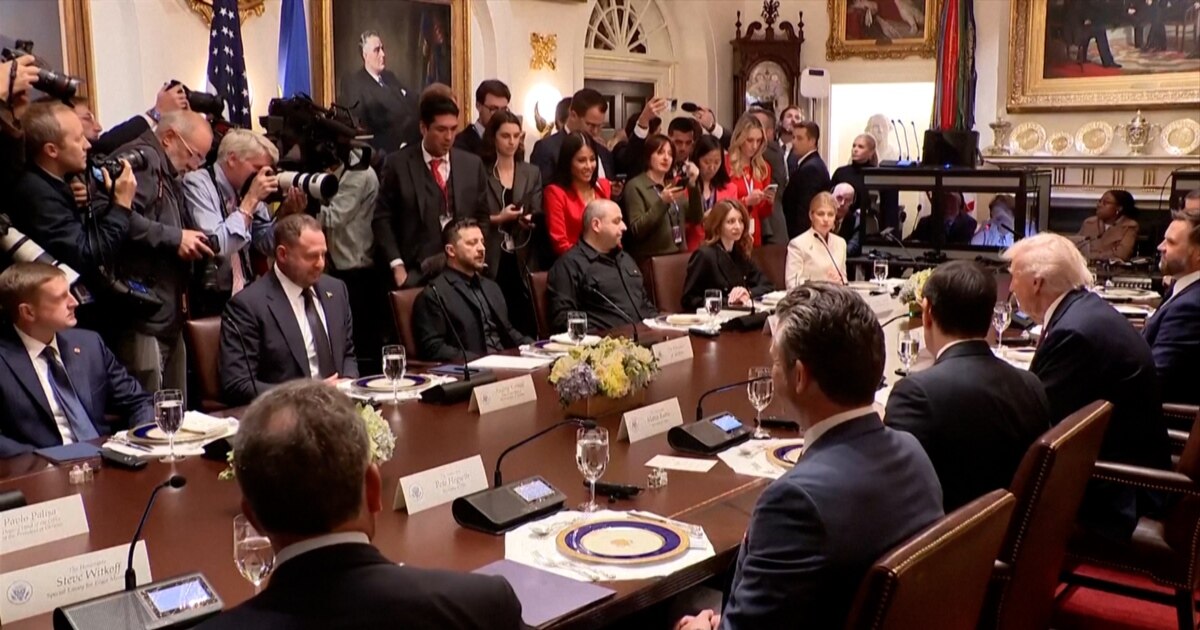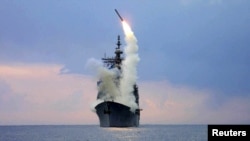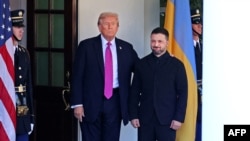The talks in Washington between US President Donald Trump and Ukrainian President Volodymyr Zelenskyy did not produce any major breakthroughs, but nor did they break down in acrimony, and the diplomatic process has been kept on the road — next stop Budapest.
Ahead of the visit there was much talk of Zelenskyy seeking Tomahawk missiles or other weapons to help his country continue its fight nearly four years after Russia’s full-scale invasion.
But many observers said this was always an unrealistic expectation.
Tomahawks
“The Ukrainians didn’t come expecting it to happen, so in that sense it’s not exactly a disappointment,” Jeremy Shapiro, research director of the European Council on Foreign Relations, told RFE/RL.
“There’s no way the US military would give them up. They’re too expensive,” he added, noting also that the Ukrainian armed forces do not have the naval assets for launching Tomahawks.
Nevertheless, the symbolism of the potential that they would be provided provoked a strong Kremlin reaction and appears to have prompted Russian President Vladimir Putin to call Trump on October 16.
The supply of Tomahawks would underline how far the administration has moved from its early months, when Trump voiced optimism that he could quickly bring about a negotiated end to the war.
Zelenskyy noted after the talks in the White House that while there was no agreement to provide Tomahawks, Trump has not entirely taken them off the table.
Ilan Berman, Senior Vice President of the American Foreign Policy Council, told RFE/RL this was significant.
“The question now is whether it’s possible for the White House to put together a package of sticks that Russia will really respond to in a way that it hasn’t before. And I think that’s where the Tomahawks come in,” said Berman, who is also a member of the RFE/RL board.
“My sense is that’s sort of what is animating the thinking. But I think both the president and his advisers are far less optimistic about Vladimir Putin being a constructive actor than they were six months ago.”
Gloom In Ukraine
Some analysts in Ukraine took a gloomy view of the talks, pointing in interviews with RFE/RL’s Ukrainian Service to the lack of any concrete agreements or announcements.
“The substantive story is that, as of November 1, we have no mechanisms for obtaining weapons from the US. The previous [aid] package has ended, and the new budget only allocates $500 million. That’s half of a Patriot battery,” said Valeriy Chaliy, Ukraine’s ambassador to Washington from 2015 to 2019.
Indeed, the urgent need for additional military support was made clear in the days leading up to the summit as Russian drone and missile strikes continued to rain down on Ukrainian cities.
The Kiel Institute, which tracks aid to Ukraine, noted a 57-percent drop in military support allocations from European countries over July and August compared to the first six months of the year.
The Germany-based institute noted that this included contributions to the new PURL scheme, under which European countries purchase US military equipment for Ukraine after the United States stopped its own new aid packages earlier in 2025.
Zelenskyy said he had discussed air defenses with Trump, but he had no new supplies to report.
Amid the lack of substantive progress, attention inevitably turned to the mood. In a social media post afterward, Trump described it as “cordial” and it certainly contrasted to the bitter exchange between Trump and Zelenskyy in the Oval Office in February.
On that occasion, lunch was canceled. This time, the two men sat with their teams at a table that was already set.
“Trump has softened [his stance on Ukraine]. This is much better than during the first months of his presidency,” Volodymyr Dubovyk, associate professor of international relations at Odesa University, told RFE/RL’s Ukrainian Service.
“I don’t see [this meeting as a] failure. I see a positive dynamic,” he added.
Maintaining The Relationship
Analysts in Washington agreed that this was the positive takeaway: the relationship between the two leaders has been kept on track.
“Let’s take it as a sequence rather than as a one-off event. When we think about it as a sequence, the Ukrainians have really progressed since that…dressing down at the White House,” said Berman.
Shapiro noted that Zelenskyy “has established a sort of parallelism with…Trump-Putin summits. He’s basically got this idea [accepted] that Trump is always going to meet with [Putin] as well at the same time, or roughly the same time.”
It’s by no means clear whether that means Zelenskyy could also travel to Budapest, where Trump says he will be meeting Putin in the near future.
Trump, when asked about it, said the talks would “most likely be a double meeting” but with Zelenskyy “in touch.” He added that “we will be involved in threes, but it may be separated.”
The details of the format still need to be thrashed out. Trump also indicated that he was concerned that Putin was trying to string the process out for as long as possible.
Again, it’s not clear how long the US president will give him before, at some point, he decides to apply additional pressure via sanctions, secondary tariffs on Russian energy importers, or new military supplies.
For now, this summit was inconclusive, and Putin has gained a little more time.


